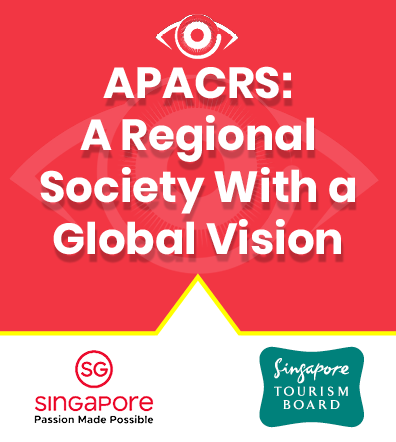Eyeworld Weekly Update |
Volume 19, Number 31 |
12 September 2014 |
- IC-8 granted CE mark
- Novaliq announces positive results from dry eye study
- Clearside granted patent for microneedle drug delivery
- Avedro buys IROC Innocross
- Alphaeon to buy Clarion Medical, gets Evosyal IND approved
IC-8 granted CE mark
The IC-8 small aperture IOL (AcuFocus, Irvine, Calif., U.S.) has been granted the CE mark in Europe, AcuFocus said in a press release. The "extended depth of focus" lens is designed for patients with both presbyopia and cataract, AcuFocus said.Novaliq announces positive results from dry eye study
An observational study that placed over-the-counter drops in 30 patients with symptoms of mild to moderate evaporative dry eye disease successfully demonstrated effectiveness and safety in relief of dry eye symptoms, developer Novaliq (Heidelberg, Germany) said in a news release.NovaTears OTC, the first product based on Novaliq's proprietary EyeSol technology, is an innovative multi-dose, non-aqueous, non-blurring, and preservative-free topical eye drop formulation for lubrication of the ocular surface. It is intended for use as a wetting agent for the ocular surface and for stabilization of the tear film for the relief of dry eye and irritated eyes symptoms, Novaliq said.
The primary objective of the open, prospective, uncontrolled post-market clinical follow-up study (treatment survey) was to confirm whether artificial tears product NovaTears was able to successfully lubricate the ocular surface, stabilize the eye's tear film, and relieve adverse symptoms associated with dry eye disease. Tear film fluid and stability improved over the study period (measured with Schirmer's I and tear film break-up time tests), tear osmolarity remained unchanged, and assessment by a subjective dry eye questionnaire revealed that patient symptom severity decreased after a 5-7 week period. Corneal staining (measured using the Oxford Grading Scheme) indicated less corneal damage after treatment, as demonstrated by patient shift toward Grade 0 at follow-up. No changes were observed in either visual acuity or intraocular pressure, Novaliq reported.
NovaTears has been classified as a class IIa medical device and received CE mark approval in Europe in July 2013.
Clearside granted patent for microneedle drug delivery
Clearside Biomedical (Alpharetta, Ga., U.S.) has been issued a patent for "Methods and Devices for Drug Delivery to Ocular Tissue Using Microneedle," the company said, noting this is the fourth patent issued for the company's microneedle drug delivery methods and devices. The latest patent provides exclusivity for the administration of any drug to a patient's eye by inserting a hollow microneedle into the eye, and infusing the drug into the suprachoroidal space. The patent is from ongoing collaborative work of Clearside, Georgia Tech Research Corporation, and Emory University.Avedro buys IROC Innocross
Avedro (Waltham, Mass., U.S.) has purchased IROC Innocross (Zug, Switzerland), the first company to commercialize a crosslinking device for the treatment of keratoconus and other corneal pathologies. To date, IROC Innocross has sold its UV-X devices to more than 1,000 ophthalmologists, Avedro said in a news release. The purchase adds to Avedro's line of corneal crosslinking procedures, including its UV-X and MedioCross devices for corneal pathologies, and its KXL system and VibeX riboflavin.Alphaeon to buy Clarion Medical, gets Evosyal IND approved
Alphaeon (Irvine, Calif., U.S.) will buy Canadian-based Clarion Medical Technologies, a leading provider of medical and aesthetic equipment and consumables in Canada. Terms of the deal were not released.In other news, Alphaeon said the Food and Drug Administration accepted its Investigational New Drug (IND) application to conduct clinical studies for Evosyal, an advanced botulinum toxin type A neurotoxin that was acquired by Alphaeon in a previous purchase. Evosyal is "state-of-the-art in both consistent manufacturability and potency as a 900 kDa neurotoxin molecular complex with high purity," according to the news release. Alphaeon expects the study to be fully enrolled by the end of 2014.
RESEARCH BRIEFS
- The efficacy, safety, and predictability profiles of 3 refractive lenticule extraction techniques were good over a 12-month follow-up, according to a study. M. Ang and colleagues at the Singapore National Eye Centre evaluated femtosecond lenticule extraction (FLEx), small incision lenticule extraction (SMILE), and pseudo small incision lenticule extraction performed between 1 March 2010 and 1 November 2012 using the VisuMax 500 kHz femtosecond laser system (N=88). Three months postoperatively, the mean overall efficacy index of refractive lenticule extraction was 0.89±0.22 (SD), with 95.5% of eyes attaining an uncorrected distance visual acuity (UDVA) of better than 20/40 and 60.2% of better than 20/20. Of all eyes, 95.5% were within ±1.00 D and 78.4% within ±0.50 D of the attempted correction. At 3 months, all small incision lenticule extraction eyes and 96.7% of pseudo small incision lenticule extraction eyes had a UDVA of 20/40 or better, while femtosecond lenticule extraction eyes had a lower efficacy index (87.0%). However, efficacy was comparable in all three groups by 12 months. The study is published in the Journal of Cataract & Refractive Surgery.
- The depth and width of the anterior chamber angle in pseudophakic eyes with posterior capsule opacification (PCO) increased significantly after Nd:YAG laser capsulotomy, as shown by anterior segment optical coherence tomography (AS-OCT), M. Eliaçık and colleagues found. They evaluated 43 eyes of 43 consecutive pseudophakic patients with symptomatic posterior capsule opacification (PCO) that underwent Nd:YAG laser capsulotomy. Anterior chamber depth (ACD) and angle width in pseudophakic eyes with posterior capsule opacification were measured with AS-OCT before and 3 days after Nd:YAG laser capsulotomy. Main outcome measures were the changes in anterior chamber depth and angle width parameters. Preoperative and postoperative measurements of anterior chamber depth and angle width included the angle opening distance, measured as the perpendicular distance from the trabecular meshwork at 500 μm and 750 μm anterior to the scleral spur to the anterior iris surface (AOD500 and AOD750, respectively), and anterior chamber angle (ACA) in the nasal and temporal quadrants. Before Nd:YAG laser capsulotomy, mean ACD, AOD500, AOD750 and ACA (nasal and temporal) measurements were 3.71±0.11, 0.61±0.054, 0.67±0.063, 34.5 degrees±1.67 degrees, and 34.8 degrees±1.55 degrees, respectively. Three days after Nd:YAG laser capsulotomy, mean ACD, AOD500, AOD750 and ACA (nasal and temporal) measurements were 3.77±0.1, 0.69±0.06, 0.73±0.06, 35.51 degrees±1.64 degrees, and 36.17 degrees±1.51 degrees, respectively (P<0.01 for all). The study is published online ahead of print in the American Journal of Ophthalmology.
- An 18-year follow-up of normal-tension glaucoma (NTG) patients receiving medical therapy found disc hemorrhage and intraocular pressure (IOP) fluctuation were associated with VF progression. S. Komori and colleagues retrospectively reviewed the medical records of 78 eyes of 78 NTG patients. The average intraocular pressure (IOP) before treatment was 15.1±1.9 mmHg and the average treated IOP was 13.5±1.5 mmHg with 2 medications. Disc hemorrhage (DH) was observed in 30 eyes (38.5%). The mean visual field progression rate was -0.38±0.30 dB/year in the disc hemorrhage group and -0.24±0.28 dB/year in the non-disc hemorrhage group (P=0.012). Multiple logistic regression analysis identified disc hemorrhage [relative risk (RR) 4.28; P=0.028] as a risk factor for VF progression using the mean deviation criterion. The study is published online first in Graefe's Archives of Clinical and Experimental Ophthalmology.
- Geuder (Heidelberg, Germany) introduced the Szurman DMEK implantation cartridge, developed by Prof. Dr. med. Peter Szurman. This cartridge ensures a contactless and atraumatic intake of the fragile Descemet's lamella by smooth aspiration. Its streamlined design and embedding in liquid helps foster a gentle injection into the anterior chamber of the patient's eye, Geuder said. Due to the more tapered opening of the cartridge with only 1.6 mm, a minimal incision size for clear cornea transplantation of 2.4 to 2.75 mm can be achieved, the company added.
- BioLight (Tel Aviv, Israel) has initiated sales of its IOPtiMate system in Hong Kong, the company noted, after receiving regulatory approval from Chinese authorities in March. The IOPtiMate system is based on CO2 laser technology that enables the performance of a unique filtration surgery to treat glaucoma without penetrating the inner part of the eyeball, thus allowing for substantial reductions in postoperative complications and use of eye drops compared with alternatives, BioLight said.
 Licensed Publications |
Licensed through ASCRS American Society of Cataract and Refractive Surgery, 4000 Legato Road, Suite 700, Fairfax, VA 22033-4003, USA.
All rights reserved. The ideas and opinions expressed in EyeWorld Asia-Pacific Weekly News do not necessarily reflect those of the ASCRS�ASOA or APACRS. Mention of products or services does not constitute an endorsement by the ASCRS�ASOA or APACRS. Copyright 2008, EyeWorld News Service, a division of ASCRS Media. |



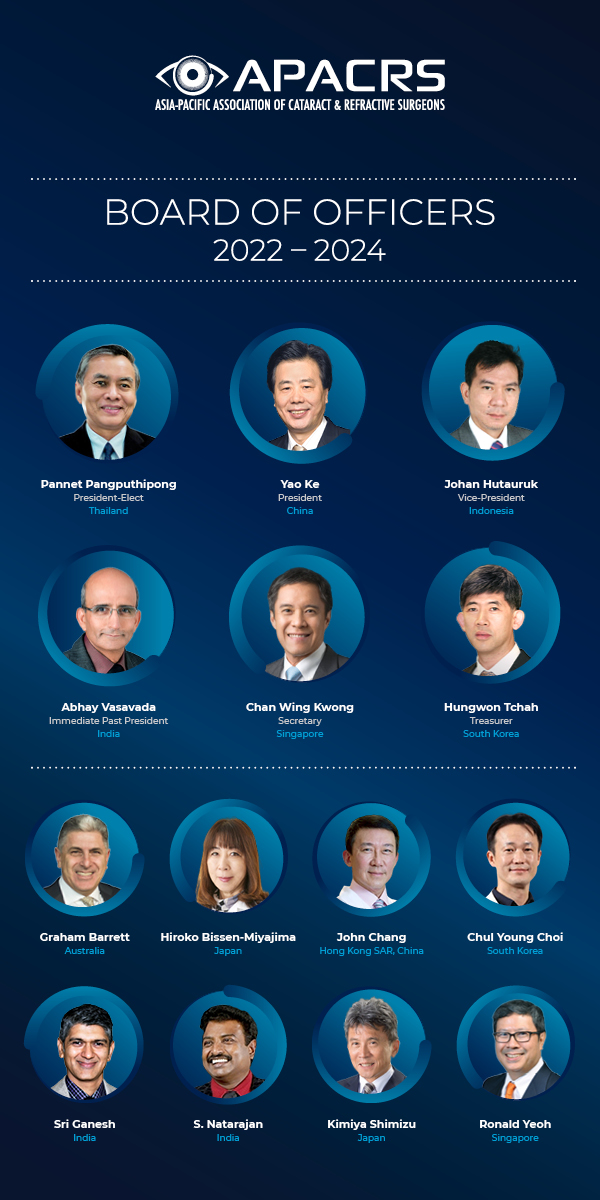
 EyeSustain Update
EyeSustain Update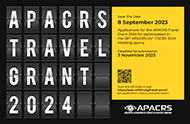 2024 APACRS TRAVEL GRANT
2024 APACRS TRAVEL GRANT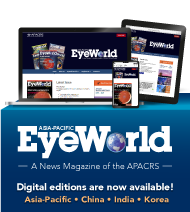 Digital EyeWorld
Digital EyeWorld VOL. 39 (2023), ISSUE 3
VOL. 39 (2023), ISSUE 3  Membership Information
Membership Information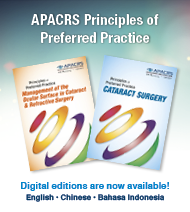 APACRS Principles of Preferred Practice
APACRS Principles of Preferred Practice